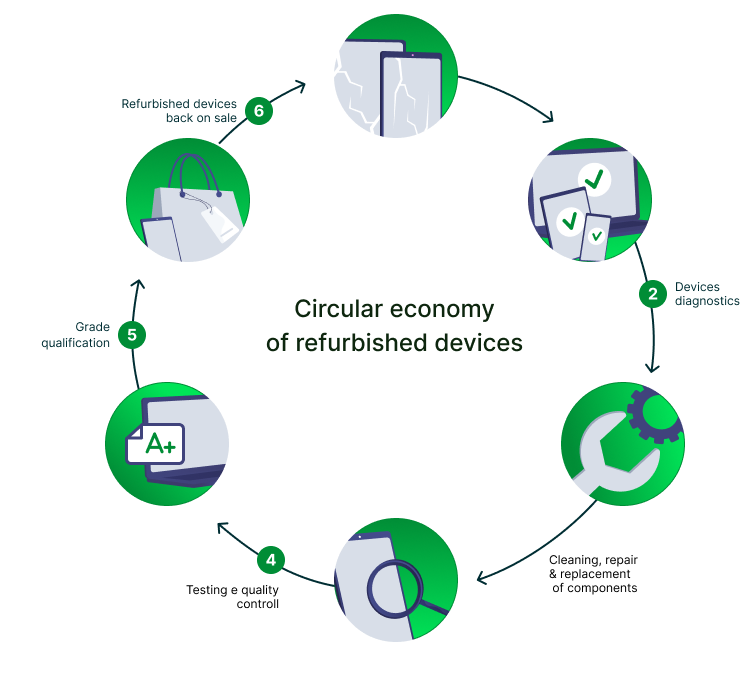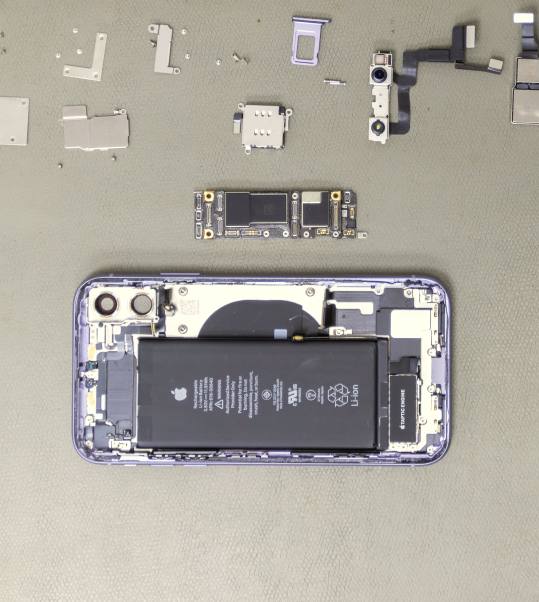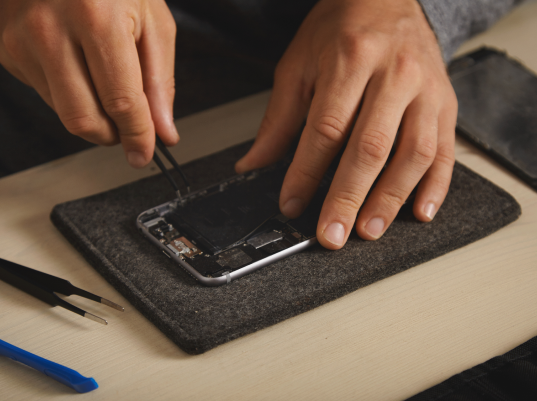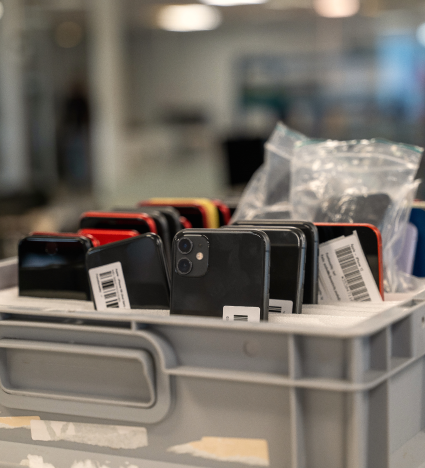MAKING A
DIFFERENCE
our manifesto
Who we are and what we believe in
EUREFAS (European Refurbishment Association) was created in 2021 to fulfil a simple objective: to enable the major actors of this growing sector to speak with one voice with EU institutions and other stakeholders.
From the start, EUREFAS ambition has been to defend a qualitative and sustainable refurbishment industry, with a focus on benefiting the planet and promoting local and circular economies. All our actions revolve around three core principles:
Promotion of sustainable industries growth
Establishment and maintenance of high quality standards for refurbished products that put the interests of end-users first.

DIFFERENCE

20 industry leaders from 10 countries
Refurbishment, you said?
Refurbishment is the professional process of giving devices a second life. It involves collecting, testing, cleaning, data wiping and, if necessary, repairing devices to ensure they function properly before being placed back on the market
Currently refurbishment market in Europe
2023 expectation growth worldwide from $27 billion in 2019

A growing European industry offering concrete solutions to many challenges

Repairing and refurbishing can unlock savings of up to
Boosting the European industry & strengthening European sovereignty
Refurbishment – by extending the lifespan of devices – not only reduces our dependence on imports from third countries, but also revitalises the European economy.
Refurbishing devices in the EU offers a unique opportunity to bring back some of the digital sector’s added value back to Europe.
While most devices are designed and manufactured outside of Europe, the EU refurbishment sector is already making a substantial contribution. It already comprises a diversified network of actors, from small to industrial companies, generating subsequent revenues and stimulating the creation of direct and indirect local jobs.
In addition, refurbishment strengthens Europe’s strategic autonomy by reducing our reliance on critical raw materials sourced. This helps enhance European sovereignty and decreases the EU’s dependance on third countries.
A cost-effective solution for local growth and competitiveness
In a world where electronic devices are essential, they also can significantly impact the purchasing power of Europeans, especially amid rising inflation.
As a result, and not surprisingly, the global smartphone market has diversified in recent years. In this context, refurbishment offers consumers with an opportunity to access essential goods while saving money without compromising on quality and contributes to reducing digital inequality. Repairing and refurbishing can unlock savings of up to 70% per device.
Refurbishment provides significant socio-economic benefits at local level, particularly in terms of creating employment. Opting for refurbished products not only stimulates Europeans’ purchasing power but also supports local economies.
A cornerstone of circular economy
Not only does refurbishment reduce new devices manufacturing, but it also helps slow down the production of new electronic devices, and e-waste production – which tops 50 million tons yearly – by bringing value to our used devices instead of discarding them in landfills.
Did you know that electronic devices account for 80% of the environmental footprint of digital technology?
By extending the lifespan of devices, refurbishment can reduce CO2 emissions by 87%[1] compared to manufacturing new devices. Encouraging the purchase of refurbished digital equipment is now recognised as a responsible approach to combating over-consumption, over-production and waste.In addition, refurbishment strengthens Europe’s strategic autonomy by reducing our reliance on critical raw materials sourced. This helps enhance European sovereignty and decreases the EU’s dependance on third countries.

What is needed to allow the refurbishment sector to meet its full potential, then?
01
A cost-effective solution for local growth and competitiveness
EUREFAS believes that through effective competition policies and adequate regulations and enforcement mechanisms particularly in the field of taxation (such as VAT and marginal taxation schemes, as well as the payment of copyright levies), the European Union can preserve the integrity of its single market while promoting innovation, consumer welfare, and ensuring sustainable economic resilience for the future.
A level playing field between EU and non-EU players is one of the most essential prerequisite conditions for promoting and sustaining a strong and efficient single market. As economies continue to globalise, it is the EU’s responsibility to ensure that European refurbishers can compete on an equal footing with their global counterparts.
This benefits local economies through job creation, promoting growth, fostering innovation, providing consumer choice, and supporting a more circular economy.
02
Going further on product REPARABILITY
For us, reliable repairs mean to allow for the use of compatible parts, to improve product ecodesign requirements for easier repair, to ban anti-repair practices (such as part pairing) that hinder or prevent quality independent refurbishment, and to extend software compatibility.
One of the main challenges for the refurbishment industry is the lack of device modularity and the shortcomings of product design to enable easy, quality repair at reasonable prices by any professional, whether certified or independent.
Product reliability and repairability are not necessarily mutually exclusive. While recent legislative developments have been a step in the right direction, we need to be more ambitious: refurbishment remains too complex or costly compared to buying new, which discourages consumers from repairing or buying refurbished in the first place.
03
Quality to ensure consumers’ confidence
At EUREFAS, we believe that only an ambitious label that sets high quality standards for both products and organisations can generate confidence and encourage the second-hand market to flourish. This standardisation, along with clear consumer information and educational campaigns, will pave the way for a sustainable development for the refurbishment sector.
While the refurbishment sector is growing in Europe, especially among SMEs, the lack of common business or regulatory standards leaves consumers confused about product quality. This lack of standardisation can lead to scepticism and hinder market clarity.
To address these challenges, we are convinced that standardised labels, if endorsed by authorities to ensure quality assurance, are crucial for market development. These labels should be developed collaboratively with independent refurbishers and repairers to establish quality benchmarks.
04
LEGAL CLARITY – A regulatory and legal framework tailored to the second-hand sector
EUREFAS is calling for the establishment of a new classification system for economic actors involved with second-hand products, to accurately reflect their role in the product value chain.
Over the past decade, our sector has experienced consistent growth, with a recent study2 projecting an additional 8% growth in the overall market for used and refurbished smartphones between 2024 and 2029. Players have matured and are now scaling for volumes.
However, one gap persists. Until now legislation has been drafted from the perspective of new devices, and does not always take into consideration the specificities of second-hand and reused devices. A thorough fitness check of all the rules applicable to product design and compliance should be carried out to ensure they are fit for purpose in the context of repair and refurbishment activities.
05
SUSTAINABILITY- Solving the sourcing equation
As a European sector, our long term objective is to ensure local supply loops in order to be entirely self-sufficient and be an example of a true regional circular economy by supporting local economies.
However, despite the growing interest among European consumers in second-hand or refurbished consumer electronics, the European supply market is still under development and has far bigger potential than what it is today.
Low collection rates for second-hand devices are due to inadequate collection systems, a preference for recycling over reuse, and a lack of consumer awareness regarding buy-back and trade-in schemes for electronics.
To achieve our goal, we must improve take-back and collection schemes by offering attractive incentives and increasing consumer awareness programs. We call for proper implementation of the legal requirement prioritising reuse over recycling once a device is collected, which will open up sourcing opportunities at the European level.
Empowering consumers to actively participate in the circular economy can lead to a win-win situation for both the environment and the economy.
It’s time to take action and pave the way for a greener world for generations to come.
The sector is mobilising to encourage all forthcoming EU initiatives to support:
Fairness of competition practices
Boost the trust and confidence of consumers
Improving products reparability


Legal clarity tailored to the second-hand sector
Promotion of sustainability
MAKING A
DIFFERENCE


